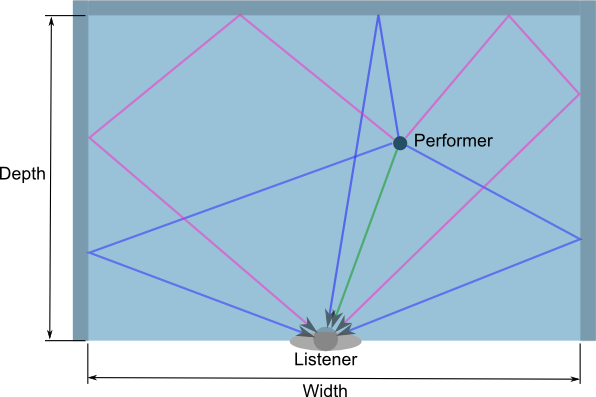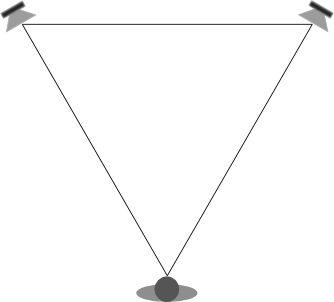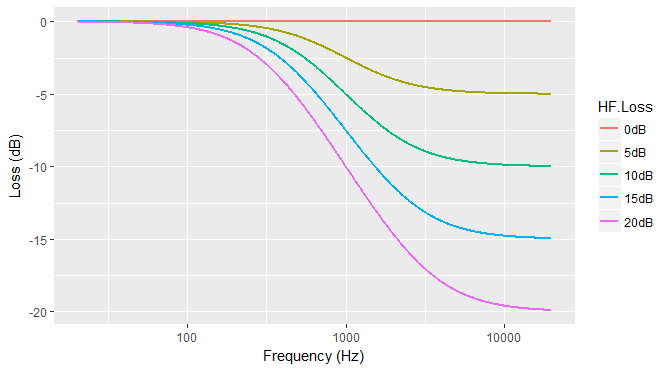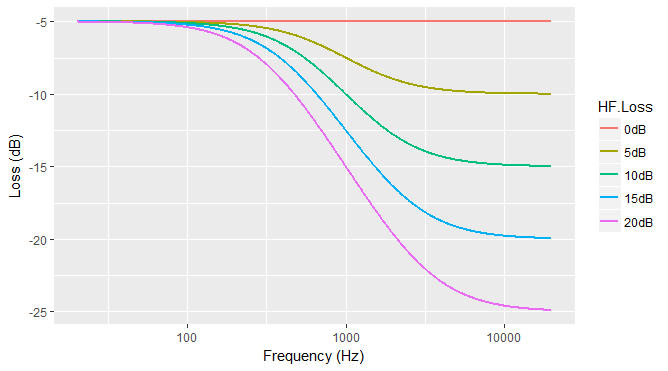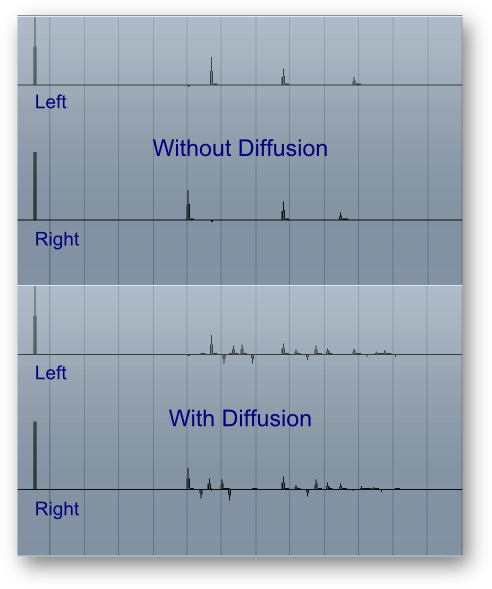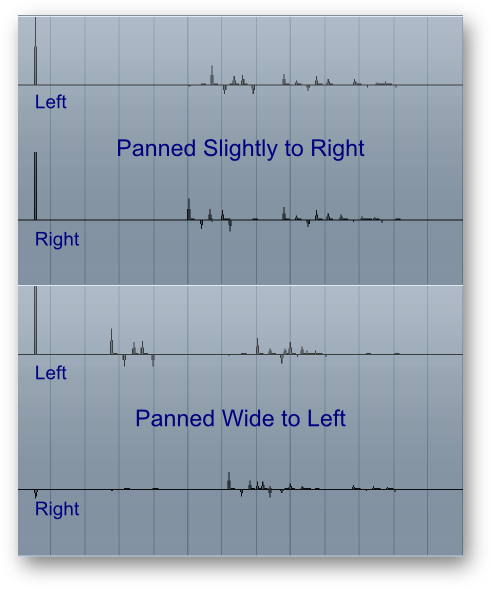Har-Bal Spatial Pan
 Har-Bal Spatial Pan is fundamentally about creating early reflections at contextually appropriate levels to imply a given geometry. In conventional recording early reflections are typically handled exclusively by a reverb processor or a chorus effect or both. The fundamental problem with that approach is that the early reflections in a real environment is the result of the first reflections off walls and ceiling and these change with performer position. However, early reflections synthesized within the reverb processor will result in all performers having exactly the same early reflections irrespective of performer position. This is clearly wrong in a physical sense and sets up an acoustic contradiction in the sense that the early reflections are implying one position yet the pan setting is implying another. At best it is an approximation of the situation where all performers are in a central mass in a large stage, where the early reflections from each performer are approximately the same, although how often is this the case in real studio mixes?
Har-Bal Spatial Pan is fundamentally about creating early reflections at contextually appropriate levels to imply a given geometry. In conventional recording early reflections are typically handled exclusively by a reverb processor or a chorus effect or both. The fundamental problem with that approach is that the early reflections in a real environment is the result of the first reflections off walls and ceiling and these change with performer position. However, early reflections synthesized within the reverb processor will result in all performers having exactly the same early reflections irrespective of performer position. This is clearly wrong in a physical sense and sets up an acoustic contradiction in the sense that the early reflections are implying one position yet the pan setting is implying another. At best it is an approximation of the situation where all performers are in a central mass in a large stage, where the early reflections from each performer are approximately the same, although how often is this the case in real studio mixes?
At a fundamental level early reflections should be part of the panning and not part of the reverberation process. Har-Bal Spatial Pan provides this early reflection processing through a simple two dimensional model that models the signal paths from performer to listener, both directly and through five additional ray traced paths as indicated in the figure below.
The Paths Modelled in Spatial Pan
The direct path has no introduced propagation delay whereas the reflected paths include delays that account for the path length difference between the reflected and direct paths (sound travels at around 345 m/s creating audible delays with distance). The direct path has no delay to ensure that the timing between parts in a mix does not change with changing position, only the reflection delays change. Another aspect the model also includes is attenuation with distance (6dB for every doubling of distance past the near field / far field transition point). Thus, as the performer is moved away from the listener the level drops and becomes increasingly similar in volume to that of the reflected paths resulting in the sense of distance.
The modelled reflections also include the incident angle of arrival at the listener which is modelled through the Wide Pan algorithm. This algorithm is built around the notion of reconstructing the approximate head transfer function for a given pan position as a linear combination of the output from two speakers in a stereo equilateral triangle configuration.
Assumed Listening Configuration for Wide Pan Algorithm
The Wide Pan algorithm is effective over an arc of +/-90 degrees angle of incidence relative to the listener. As such, Spatial Pan only models reflections forward of the listener. The listener position, whilst adjustable horizontally, remains fixed to the base line of the modelled space. Despite these restrictions it provides realistic synthetic early reflections that closely mimic the behaviour of regular sound spaces. As most mixes will only ever want the performer forward of the listener the restrictions within Wide Pan typically do not form an impediment. Whilst contrasting technologies using head transfer function modelling can resolve position in an arc of +/-180 degrees they are computationally expensive. Wide Pan in contrast, is very cheap and not much more expensive than implementing conventional panning. As such, Spatial Pan can be applied to many channels simultaneously without presenting a computational load problem to your digital audio workstation. Although specifically design for stereo speaker sound reproduction, Spatial Pan still provides a pleasant listenening experience in stereo headphones very much similar to the manner in which current stereo mixes translate to headphones.
The reflections themselves include a loss model which is parameterised by an all-band loss component plus an additional high frequency loss component to account for the deadening of higher frequencies in typical real spaces. This is implemented using a first order lead-lag filter with the response characteristic as illustrated in the figure below.
The High Frequency Loss Behaviour for Different HF Loss Settings, HF Transition 1kHz
The all band loss term is added to the high frequency loss term. For instance, with an all band loss term of 5dB (just referred to as Loss in the user interface) the following loss behaviour results. Note that the shape is exactly the same as above but the low frequency loss begins at -5dB instead of 0dB in the previous case.
The High Frequency Loss Behaviour for Different HF Loss Settings and an All Band Loss of 5dB, HF Transition 1kHz
Remember that the reflection model only models 5 different reflection paths in the horizontal plane, so whilst it sounds quite realistic it lacks the complexity of a real performance space which will have many more early arrival reflections of differing strengths. To add extra complexity to the early reflections Spatial Pan also includes a 7 tap tapped delay line in series with the reflection processing. In a physical sense this can be thought of as adding orthogonal floor to ceiling reflections (by that I mean reflections that follow the main reflection path when viewed from above) to the existing 5 reflection paths. This then gives a model that totals 35 reflection paths. These added reflections are referred to within the wall reflection model as diffusion. This behaviour is illustrated in the Figure below.
A Typical Impulse Response of Spatial Pan when Panned Slightly Right Illustrating the Change that Diffusion makes to the Response
To make clear the connection between early reflections and position and how they are tied together, consider the figure below which shows the impulse responses for two postions : one fairly central and closer to the listener but panned slightly right and the other widely panned to the left and further away from the listener. Note in particular the very different reflections between the two positions. These reflections serve to further define the location of the listener and the location of the walls and rightly change with position. In contrast, using a fixed reverb processor or chorus effect to simulate early reflections will result in a common reflection pattern for all channels sent through it irrespective of the channel panning. Such an approach will likely sound less realistic because of the acoustic ambiguity set up between the pan position and what the modelled early reflections are telling your brain about position. In contrast, Spatial Pan provides early reflections that are consistent with the position to within the accuracy of the panning model and is therefore less likely to sound acoustically ambiguous.

